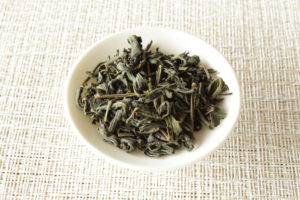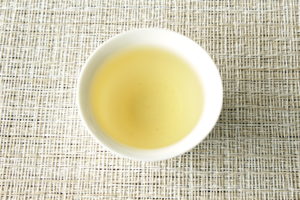 Many thanks to Ippin for giving me a sample of this interesting tea.
Many thanks to Ippin for giving me a sample of this interesting tea.
The brand is Kawamotoya. It’s the first time that I try it.
This lightly oxidized oolong is made in Makinohara, Shizuoka prefecture.
They also produce a more oxidized version called Red oolong tea.
Japanese oolong tasting
I have little experience with Japanese oolongs, because they aren’t very common.
This is a good chance to learn more about this type of tea.
The tea leaves have a slightly sweet and fruity aroma. Definitely different from a Japanese green tea.
It consists of medium sized leaves that are quite twisted.
Their color is grey-green, and there’s a roughness to their texture.
Finally, there are some stems present.
I prefer the gongfu style to review oolongs, which means using a gaiwan and making short infusions of about 30 seconds.
After the first infusion, I tried to describe the aroma of the wet leaves but I just couldn’t identify it.
It seemed very familiar, but also so unusual for a tea.
Then it came to me, it smells just like an eggplant! I’m pretty sure that the tea leaves smell just like it.
 The liquor is a clear yellow. It looks good.
The liquor is a clear yellow. It looks good.
I tried to forget about the eggplant, and concentrated on the tea’s taste.
It’s a mellow flavor, with a faint sweetness. I think that it might be a bit light.
Although this tea is much different from what I’m used to drinking, it has a pleasant taste.
For the second infusion, I found that the taste improved in the sense that it was stronger.
The third infusion resulted in a yellow color, brighter than before. Taste-wise, it was similar to the second infusion.
The next two infusions were also very much alike.
It was at the sixth infusion that I decided to stop, because the flavor was much lighter.
But overall it is a good tea with no bitterness or astringency. It also offers a fresh aftertaste.
While I still prefer a Japanese green tea, this tea has such a curious aroma that I will definitely reserve a space for it in my collection to share with friends.
Here’s the product link. I had a lot of fun while tasting it 🙂






March 20, 2018
Hello Ricardo,
This sounds like a fascinating tea. Do you know how the oxidation process was initiated – by bruising or by rolling?
Thanks.
March 20, 2018
Hi David
Thanks for your comment.
There isn’t much information about this tea. The only thing I know is the origin.
I believe that the Kawamotoya company mostly sells the teas with its brand but doesn’t produce them.
March 27, 2018
Oxidation begins when the tea leaves are plucked.
Japanese tea uses the steaming (roasting) process to stop the fermentation (oxidation) immediately after the tea leaves are plucked.
On the other hand, if it only ferments (oxidizes) for half the time, it becomes oolong tea.
After completely fermented (oxidized), it becomes black tea.
Blue oolong tea is closer to green tea, and the fermentation (oxidation) process of red oolong tea is closer to black tea.
March 21, 2018
Loved this read. i haven’t seen this tea hit Australia yet through our suppliers. I will be keeping a good look out!
March 21, 2018
Hi Paul
You can also get this tea in Australia from https://au.ippin.com/